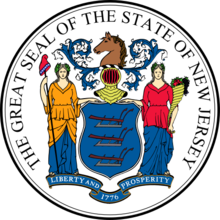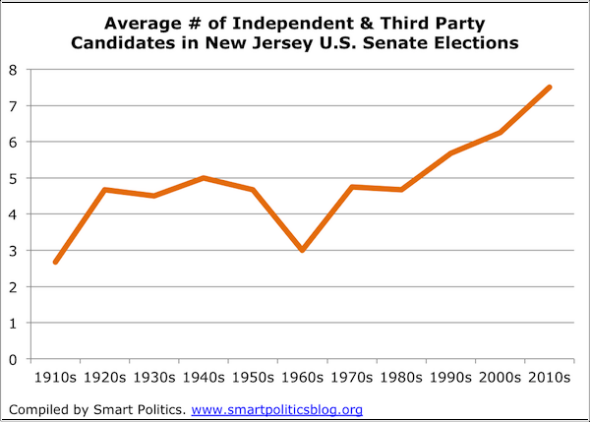The Third Wheel: States with the Most 3rd Party US Senate Candidacies
New Jersey leads a pack of Northeastern and Midwestern states with the highest rate of independent and third party candidates in U.S. Senate elections over the past century
 A few months ago there was perhaps greater suspense as to when New Jersey Governor Chris Christie would set the state’s upcoming U.S. Senate special election as opposed to which party would likely win the seat.
A few months ago there was perhaps greater suspense as to when New Jersey Governor Chris Christie would set the state’s upcoming U.S. Senate special election as opposed to which party would likely win the seat.
With some controversy, Christie set the election for October 16th – a few weeks in advance of the already scheduled general election in November.
As expected, Democratic Newark Mayor Cory Booker has been doubling up on his Republican opponent Steve Lonegan in the polls, but there is another telling aspect to the Garden State’s Senate race.
In addition to Booker and Lonegan, there will be six other candidates in the election to fill Frank Lautenberg’s old seat:
· Robert DePasquale, Independent, from Butler, New Jersey.
· Eugene Lavergne, D-R Party (West Long Branch).
· Stuart Meissner, Alimony Reform Now (Dumont).
· Pablo Olivera, Unity Is Strength (Newark).
· Antonio Sabas, Freedom of Choice (Irvington).
· Edward Stackhouse, Ed the Barber (Hamilton Square).
But it isn’t the novelty of a special election that has driven these half-dozen candidates (with colorful party names and campaign slogans) onto the ballot this October.
Rather, elections to the nation’s upper legislative chamber replete with non-major party candidates have been par for the course in New Jersey politics throughout the last century.
A Smart Politics review of U.S. Senate election data over the last 100 years finds that New Jersey far and away leads the nation for the highest rate of third party and independent candidates appearing on the ballot in U.S. Senate contests.
For this study, Smart Politics tallied every independent and third party candidate whose name appeared on a general or special U.S. Senate election ballot plus write-in candidates who received at least 0.1 percent of the vote.
Across the 1,826 popular vote U.S. Senate races conducted through New Jersey’s October 2013 special election, there have been 2,510 non-major party candidates vying for a seat, or approximately 1.4 per contest.
New Jersey, however, is in a league of its own.
During the 39 popular vote races through the October contest, there have been 187 independents and third party candidates in Garden State U.S. Senate elections, or an average 4.79 per contest.
The next closest state is New York with 121 candidates, or 3.27 per race.
Unlike most states, New Jersey has consistently placed a flurry of non-major party candidates on the U.S. Senate ballot throughout the direct vote era from the 1910s through the decade-plus of the 21st Century.
There have been no fewer than two such candidates on the ballot in any contest (1918 special, 1966) and as many as nine (1978, 2000, 2012).
With the exception of the 1910s (2.7 candidates per Senate race) and the 1960s (3.0) the Garden State has averaged at least 4.5 independent and third party candidates per race per decade, setting all time highs in the 1990s (5.7), 2000s (6.3), and 2010s (7.5).
But what makes the consistently strong presence of non-major party candidates in New Jersey U.S. Senate elections so fascinating is that none have been particularly successful, unlike strong third party movements that have flourished for a time in other states (e.g. Wisconsin and the Progressives, Minnesota and the Farmer-Laborites).
The best showing among these 15+-dozen candidates in New Jersey over the last one hundred years is the 4.1 percent received by Socialist nominee James Reilly in a 1918 race won by Republican Walter Edge.
It’s been more than 40 years since the last non-major party candidate in New Jersey eclipsed just two percent of the vote – independent Joseph Job received 2.8 percent in a 1970 election won by Democratic incumbent Harrison Williams.
Of course, variation in the number of non-major party candidates running in U.S. Senate races across the country is due not only to differences in political culture but also ballot access.
Some states have higher hurdles, such as requiring several thousand signatures for a statewide run. (New Jersey requires just 800).
Regional variations in the number of non-major party candidates gaining ballot access are quite evident at the top of the list.
Northeastern and Midwestern states populate each of the Top 7 slots as well as 12 of the Top 16.
After New Jersey and New York, Michigan has the third highest rate of independent and third party candidates per Senate contest at 3.22, followed by Pennsylvania at #4 (2.82), Illinois at #5 (2.73), Wisconsin at #6 (2.68), and Minnesota at #7 (2.21).
Colorado is the top-ranked Western state at #8 (2.19) – just ahead of California at #9 (2.16).
Tennessee is tops in the South, tied for #10 with Massachusetts (1.97).
On the other end of the spectrum, 20 states have averaged less than one independent or third party candidate on the ballot in U.S. Senate races over the last century.
At the very bottom of the list is Arkansas with just 12 such candidates, or 0.33 per election, followed by Wyoming (0.37), West Virginia (0.43), Mississippi (0.44), Georgia and North Carolina (0.45), Maine and Nebraska (0.51), New Mexico (0.54), and Idaho (0.59).
While additional U.S. Senators have switched their partisan affiliation from major parties to third parties or an independent status mid-term, just 10 have been popularly elected totaling 15 victories overall: Farmer-Laborites Henriek Shipstead (1922, 1928, 1934), Magnus Johnson (1923), and Ernest Lundeen (1936) of Minnesota, Progressive Robert La Follette, Jr. of Wisconsin (1934, 1940), independent George Norris of Nebraska (1936), Conservative James Buckley of New York (1970), independent Harry Byrd, Jr. of Virginia (1970, 1976), Independent-Democrat Joe Lieberman of Connecticut (2006), independent Bernie Sanders of Vermont (2006, 2012), and independent Angus King of Maine (2012).
South Carolina’s Strom Thurmond (1954) and Alaska’s Lisa Murkowski (2010) were also famously elected as write-in candidates while nominated candidates from their respective parties appeared on the ballot.
Update: Thanks to Richard Winger of Ballot Access News for pointing out that appointed California incumbent Republican William Knowland won a 1946 special election as a write-in candidate. (Knowland also simultaneously won election to the full term with his partisan designation, but there were no candidates on the ballot in the special).
Average Number of Independent and Third Party U.S. Senate Candidates Per Election in Direct Vote Era
|
Rank
|
State
|
#
|
Contests
|
# Per Contest
|
|
1
|
New Jersey
|
187
|
39
|
4.79
|
|
2
|
New York
|
121
|
37
|
3.27
|
|
3
|
Michigan
|
116
|
36
|
3.22
|
|
4
|
Pennsylvania
|
107
|
38
|
2.82
|
|
5
|
Illinois
|
101
|
37
|
2.73
|
|
6
|
Wisconsin
|
99
|
37
|
2.68
|
|
7
|
Minnesota
|
84
|
38
|
2.21
|
|
8
|
Colorado
|
81
|
37
|
2.19
|
|
9
|
California
|
80
|
37
|
2.16
|
|
10
|
Massachusetts
|
75
|
38
|
1.97
|
|
10
|
Tennessee
|
75
|
38
|
1.97
|
|
12
|
Indiana
|
71
|
38
|
1.87
|
|
13
|
Iowa
|
67
|
36
|
1.86
|
|
14
|
Connecticut
|
70
|
38
|
1.84
|
|
15
|
Oklahoma
|
61
|
36
|
1.69
|
|
16
|
Missouri
|
64
|
38
|
1.68
|
|
17
|
Washington
|
56
|
35
|
1.60
|
|
18
|
Virginia
|
54
|
37
|
1.46
|
|
19
|
Oregon
|
58
|
42
|
1.38
|
|
20
|
Kansas
|
52
|
38
|
1.37
|
|
21
|
Vermont
|
53
|
39
|
1.36
|
|
22
|
Utah
|
45
|
34
|
1.32
|
|
23
|
Maryland
|
44
|
35
|
1.26
|
|
24
|
Delaware
|
42
|
36
|
1.17
|
|
25
|
Hawaii
|
24
|
21
|
1.14
|
|
25
|
Texas
|
42
|
37
|
1.14
|
|
27
|
North Dakota
|
43
|
38
|
1.13
|
|
28
|
Nevada
|
44
|
40
|
1.10
|
|
29
|
Alaska
|
22
|
21
|
1.05
|
|
30
|
Arizona
|
36
|
36
|
1.00
|
|
31
|
Ohio
|
37
|
38
|
0.97
|
|
32
|
Montana
|
28
|
35
|
0.80
|
|
33
|
Alabama
|
28
|
38
|
0.74
|
|
34
|
New Hampshire
|
26
|
37
|
0.70
|
|
35
|
Florida
|
25
|
36
|
0.69
|
|
36
|
South Dakota
|
23
|
34
|
0.68
|
|
37
|
Louisiana
|
24
|
36
|
0.67
|
|
38
|
Kentucky
|
26
|
40
|
0.65
|
|
38
|
South Carolina
|
24
|
37
|
0.65
|
|
40
|
Rhode Island
|
22
|
35
|
0.63
|
|
41
|
Idaho
|
23
|
39
|
0.59
|
|
42
|
New Mexico
|
20
|
37
|
0.54
|
|
43
|
Maine
|
18
|
35
|
0.51
|
|
43
|
Nebraska
|
19
|
37
|
0.51
|
|
45
|
North Carolina
|
18
|
40
|
0.45
|
|
45
|
Georgia
|
17
|
38
|
0.45
|
|
47
|
Mississippi
|
16
|
36
|
0.44
|
|
48
|
West Virginia
|
16
|
37
|
0.43
|
|
49
|
Wyoming
|
14
|
38
|
0.37
|
|
50
|
Arkansas
|
12
|
36
|
0.33
|
|
|
Average
|
2,510
|
1,826
|
1.37
|
Note: Includes write-in candidates who received at least 0.1 percent of the vote. Table compiled by Smart Politics.
Follow Smart Politics on Twitter.


Re Update, ‘Nolan’ is obviously a typo. Knowland’s principal opponent in ’46 was ex- US Rep Will Rogers, Jr. Curiously they both took their own lives. Why was the special election ballot blank ?
You have to appreciate a moderate like Eugene Martin LaVergne. One of the few people in the country that will stand up for the Congressional Apportionment Amendment from the Bill of Rights. Google it.